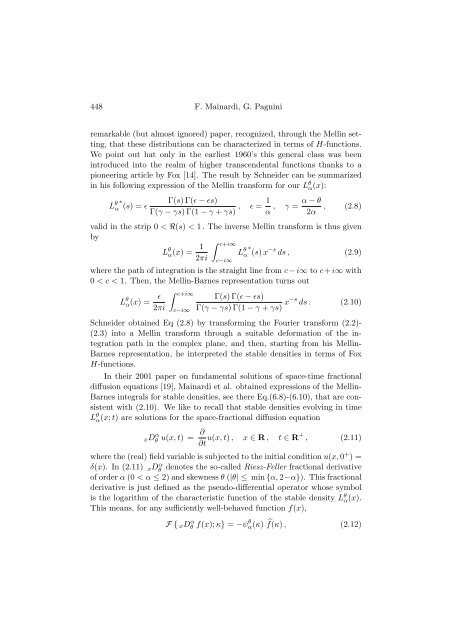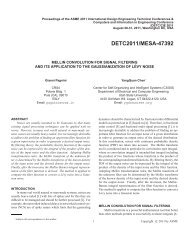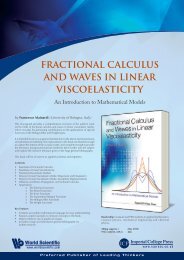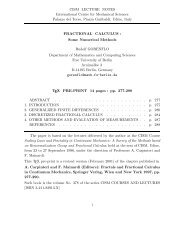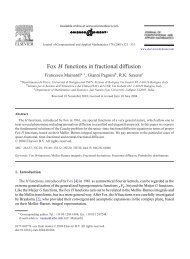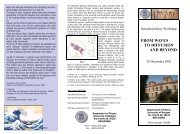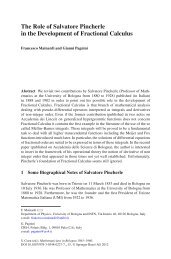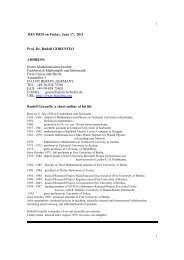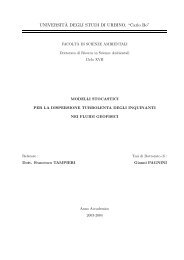MELLIN-BARNES INTEGRALS FOR STABLE DISTRIBUTIONS AND ...
MELLIN-BARNES INTEGRALS FOR STABLE DISTRIBUTIONS AND ...
MELLIN-BARNES INTEGRALS FOR STABLE DISTRIBUTIONS AND ...
Create successful ePaper yourself
Turn your PDF publications into a flip-book with our unique Google optimized e-Paper software.
448 F. Mainardi, G. Pagnini<br />
remarkable (but almost ignored) paper, recognized, through the Mellin setting,<br />
that these distributions can be characterized in terms of H-functions.<br />
We point out hat only in the earliest 1960’s this general class was been<br />
introduced into the realm of higher transcendental functions thanks to a<br />
pioneering article by Fox [14]. The result by Schneider can be summarized<br />
in his following expression of the Mellin transform for our L θ α(x):<br />
L θ ∗<br />
α (s) = ɛ<br />
Γ(s) Γ(ɛ − ɛs)<br />
1 α − θ<br />
, ɛ = , γ = , (2.8)<br />
Γ(γ − γs) Γ(1 − γ + γs) α 2α<br />
valid in the strip 0 < ℜ(s) < 1 . The inverse Mellin transform is thus given<br />
by<br />
L θ α(x) = 1<br />
c+i∞<br />
L<br />
2πi<br />
θ ∗ −s<br />
α (s) x ds , (2.9)<br />
c−i∞<br />
where the path of integration is the straight line from c − i∞ to c + i∞ with<br />
0 < c < 1. Then, the Mellin-Barnes representation turns out<br />
L θ α(x) = ɛ<br />
2πi<br />
c+i∞<br />
c−i∞<br />
Γ(s) Γ(ɛ − ɛs)<br />
Γ(γ − γs) Γ(1 − γ + γs) x−s ds . (2.10)<br />
Schneider obtained Eq (2.8) by transforming the Fourier transform (2.2)-<br />
(2.3) into a Mellin transform through a suitable deformation of the integration<br />
path in the complex plane, and then, starting from his Mellin-<br />
Barnes representation, he interpreted the stable densities in terms of Fox<br />
H-functions.<br />
In their 2001 paper on fundamental solutions of space-time fractional<br />
diffusion equations [19], Mainardi et al. obtained expressions of the Mellin-<br />
Barnes integrals for stable densities, see there Eq.(6.8)-(6.10), that are consistent<br />
with (2.10). We like to recall that stable densities evolving in time<br />
L θ α(x; t) are solutions for the space-fractional diffusion equation<br />
xD α θ<br />
u(x, t) = ∂<br />
∂t u(x, t) , x ∈ R , t ∈ R+ , (2.11)<br />
where the (real) field variable is subjected to the initial condition u(x, 0 + ) =<br />
δ(x). In (2.11) xDα θ denotes the so-called Riesz-Feller fractional derivative<br />
of order α (0 < α ≤ 2) and skewness θ (|θ| ≤ min {α, 2−α}). This fractional<br />
derivative is just defined as the pseudo-differential operator whose symbol<br />
is the logarithm of the characteristic function of the stable density Lθ α(x).<br />
This means, for any sufficiently well-behaved function f(x),<br />
F { xD α θ f(x); κ} = −ψθ α(κ) f(κ) , (2.12)


